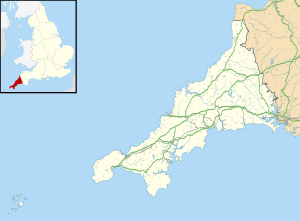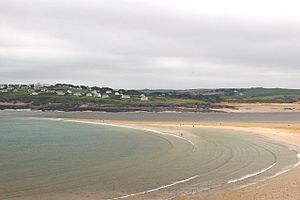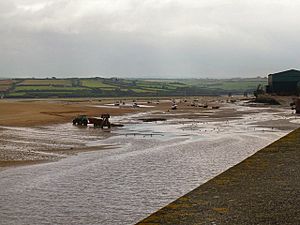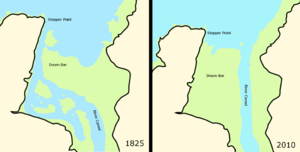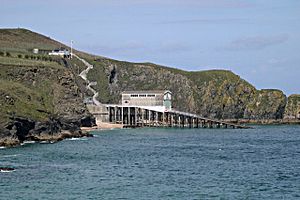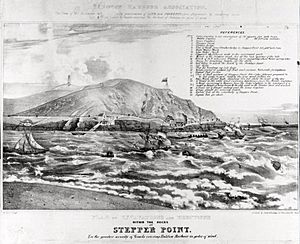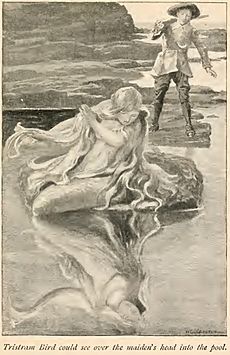Doom Bar facts for kids
Quick facts for kids Doom Bar |
|
|---|---|

Waves breaking on the Doom Bar at high water
|
|
| Location | Camel Estuary, Cornwall, England |
| OS grid | SW918777 |
| Coordinates | 50°33′45″N 04°56′24″W / 50.56250°N 4.94000°W |
| Formed by | Tidal action |
| Geology | Sandbar |
The Doom Bar is a large sandbank found at the mouth of the River Camel in Cornwall, England. This is where the river meets the Celtic Sea on the north coast of Cornwall. The Doom Bar, along with other sandbanks nearby, is made mostly of sand that comes from the ocean floor. Over 60% of this sand comes from marine shells. This makes it a great source of agricultural lime, which farmers have used for hundreds of years to improve their soil.
The area where the river meets the ocean is very active, and the sand can move a lot, especially during storms. It's believed that the Doom Bar formed around the time of Henry VIII, which caused problems for the port of Padstow nearby. For a long time, it was very hard for sailing ships to get into Padstow's harbour because of the Doom Bar. Many ships were wrecked there. Even today, it can still be dangerous. The Doom Bar is also famous for a Cornish folklore legend about a mermaid and has a local beer named after it.
Contents
What is the Doom Bar?
The Doom Bar is a sandbank located at the entrance of the Camel estuary in northern Cornwall. It's mostly made of coarse sand that ocean waves and tides push in from the seabed. This means that sand is always flowing into the estuary. The river itself doesn't bring much sand; most of its sediment settles further upstream.
There are three main sandbanks in the Camel estuary. The Doom Bar is one, the Town Bar is near Padstow, and the Halwyn Bank is just past Padstow. All three are similar. A lot of their sand comes from mollusc shells, which means they have a high amount of calcium carbonate. This calcium carbonate makes the sand useful for liming (improving) farm soil. Farmers have used this sand for centuries, even before the 1600s. The mix of calcium carbonate and sea salt made it a valuable alkaline fertilizer when mixed with manure.
People have been removing sand from the estuary for a very long time. In the 1800s, many men worked to dredge (remove) sand from the area. It's thought that over 10 million tons of sand were taken from the estuary between 1836 and 1989, mostly for farming. Even today, sand is regularly dredged from the Doom Bar and the surrounding area. For example, in 2009, about 120,000 tons of sand were removed.
There's even a submerged forest hidden beneath the eastern part of the Doom Bar. It's believed to be part of an ancient wooded plain that was covered by sand dunes and beach sand as sea levels rose about 4,000 years ago. Because the area faces the Atlantic Ocean, the sands can shift suddenly. It's said that the Doom Bar formed during the time of Henry VIII (1509–1547), which led to Padstow becoming less wealthy. Today, the sandbank covers about 0.4 square miles, connecting beaches with sand flats, though its exact size and shape change over time.
The name "Doom Bar" comes from an older name, Dunbar, which itself means dune-bar. Although it was often called "Dunbar sands" before 1900, the name "Doom Bar" was used as early as 1761 and appeared in poems and official papers in the 1800s.
Why was the Doom Bar Dangerous?
For hundreds of years, the Doom Bar was very dangerous for ships. Sailing ships trying to enter Padstow's harbour would often lose the wind as they passed Stepper Point. This made it hard to steer, causing them to drift towards the sandbank. Sometimes, strong gusts of wind would push ships onto the sand. Dropping anchor didn't help much because the anchor couldn't get a good grip in the sand. In fact, the Doom Bar was so risky that during storms, ships would sometimes choose to risk wrecking on the coast rather than try to navigate the channel into Padstow.
To help ships, people installed mooring rings and capstans (machines for pulling ropes) on the cliffs. They even quarried (removed rock from) part of Stepper Point to help ships catch the wind better. In the early 1900s, the main channel for boats moved away from the cliffs. Regular dredging has also made it much safer for boats to pass.
In the 1800s, there were ideas to remove the Doom Bar completely, perhaps by building a breakwater or using guide walls to direct water across it. However, experts believed the sand would just build up again. They also noted that the sand was "hard sand," making it difficult to remove. Despite these challenges, Padstow was seen as the only safe harbour in the area during dangerous north-westerly gales. So, efforts were made to improve access.
Today, the Doom Bar is still regularly dredged by the Padstow Harbour Commission's dredgers, Sandsnipe and Mannin, to keep the channel open and safe.
Famous Shipwrecks
Since records began in the early 1800s, the Doom Bar has been responsible for over 600 incidents involving ships, including many wrecks.
To help ships in trouble, pilots would wait at Stepper Point to guide vessels into the harbour. If a ship was sinking, salvors (people who rescue ships or their cargo) would help.
In 1827, the Royal National Lifeboat Institution helped fund a permanent lifeboat at Padstow. Two years later, a lifeboat house was built at Hawker's Cove. In 1879, four granddaughters of the local patron and their friend rescued a drowning sailor on the Doom Bar. This was very unusual for women at the time, and all five girls received a Silver Medal for their bravery. Even with modern technology, the Royal National Lifeboat Institution still responds to incidents at the Doom Bar.
HMS Whiting
The only warship known to have wrecked on the Doom Bar was HMS Whiting. This was a 12-gun schooner that the Royal Navy had captured. On September 15, 1816, the Whiting ran aground on the Doom Bar. The tide was going out, and the wind was blowing in the wrong direction. They tried to move her at the next high tide, but she was taking on too much water and couldn't be saved.
The ship was abandoned, and the crew salvaged what they could. The officer in charge was punished for negligence. In 2010, a group of marine researchers and a local school searched for the wreck, but they haven't found it yet.
Antoinette
The largest ship believed to have wrecked on the Doom Bar was the Antoinette, a large barque built in 1874. On New Year's Day in 1895, she left Newport with coal for Brazil. She ran into trouble near Lundy Island, losing parts of her mast. A steam tug tried to tow her to Padstow, but she hit the Doom Bar and sank quickly.
Attempts to remove the wreck failed. Later, the middle part of the ship floated up the estuary to the Town Bar, becoming a danger to other ships. Explosives were used to try and break it up, but they only broke windows in the town! In 2010, a wreck believed to be the Antoinette surfaced again on Town Bar. Work began in 2011 to finally remove the remaining parts of it.
The Mermaid Legend
"[The mermaid legend] is doubtless a myth, but it is a fact that a wailing cry is sometimes heard on the Doombar after a fearful gale and loss of life on that fateful bar, like a woman bewailing the dead."
According to local Cornish folklore, the Doom Bar was created by the Mermaid of Padstow. The legend says she made it as a dying curse on the harbour after a local man shot her.
In 1906, a writer named Enys Tregarthen shared a version of the story. A Padstow man named Tristram Bird wanted to shoot something special with his new gun. He went hunting seals but found a beautiful young woman on a rock. He asked her to marry him, and when she refused, he shot her. Only then did he realize she was a mermaid. As she died, she cursed the harbour, creating the "bar of doom" that stretches across the bay.
Another version of the story tells of a local man named Tom Yeo, who shot the mermaid by mistake, thinking she was a seal. John Betjeman, a poet who knew the area well, wrote in 1969 that the mermaid fell in love with a local man. When she couldn't live without him, she tried to lure him underwater. He escaped by shooting her. In her anger, she threw a handful of sand towards Padstow, and that sand grew into the sandbank. In other tales, the mermaid sings from the rocks, and a young man shoots her with a crossbow or longbow. Mermaids were sometimes believed to sing to lure people to their deaths.
The mermaid legend isn't just about the Doom Bar's creation. Some people believed that mermaids, like the Sirens of Greek myth, would lie in the shallow waters and pull ships in to be wrecked. It's also said that after a big storm where lives are lost on the sandbar, you can hear "the distressful cry of a woman bewailing her dead."
The Doom Bar has also appeared in poetry to express sad feelings. A Victorian poem called "The Doom-Bar" tells the story of a girl who gave a special ring to her love before he sailed away across the Doom Bar, breaking her heart. Years later, she found the ring inside a scallop on the sand, realizing he had thrown it away. She then decided to sail out to sea herself.
A play called The Doom Bar, about smuggling and wrecking, was written in the early 1900s. It was popular in America, but a series of accidents, blamed on a legendary wrecker named Cruel Coppinger, led to the play being considered cursed. Actors' unions even banned their members from appearing in it.
See also
 In Spanish: Doom Bar para niños
In Spanish: Doom Bar para niños


